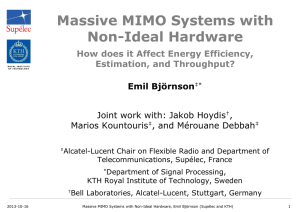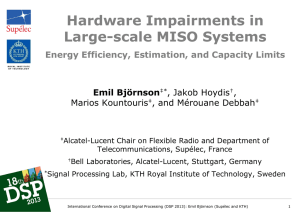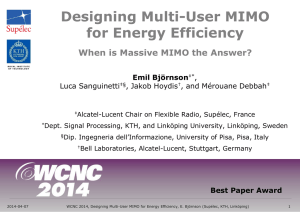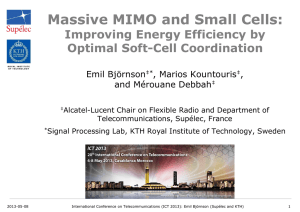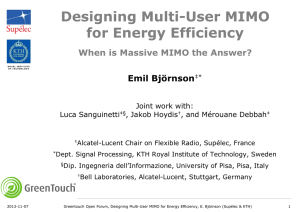Presentation - Communication Systems division
advertisement
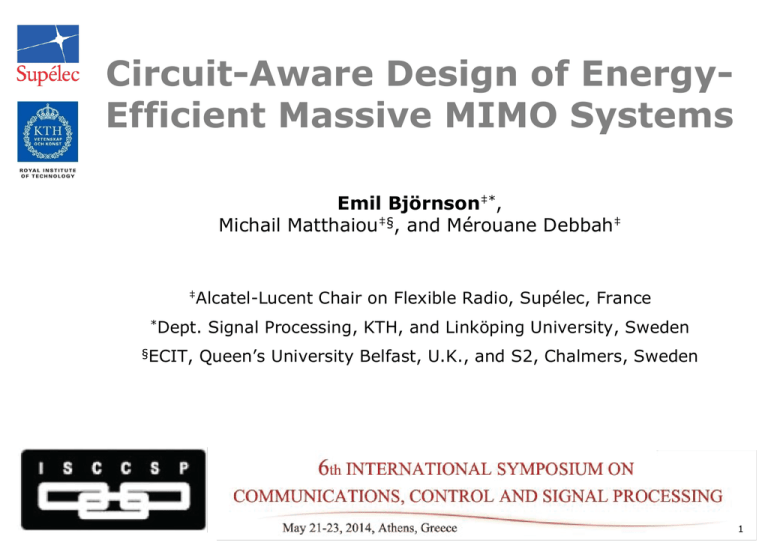
Circuit-Aware Design of EnergyEfficient Massive MIMO Systems Emil Björnson‡*, Michail Matthaiou‡§, and Mérouane Debbah‡ ‡Alcatel-Lucent *Dept. §ECIT, Chair on Flexible Radio, Supélec, France Signal Processing, KTH, and Linköping University, Sweden Queen’s University Belfast, U.K., and S2, Chalmers, Sweden 1 A Conjecture for Massive MIMO ”Massive MIMO can be built with inexpensive, low-power components.” “Massive MIMO reduces the constraints on accuracy and linearity of each individual amplifier and RF chain.” “Massive MIMO for next generation wireless systems,” by E. G. Larsson, O. Edfors, F. Tufvesson and T. L. Marzetta, in IEEE Communications Magazine, 2014. Is this true? There are some indicative results in the literature [3],[7] In this paper we provide a more comprehensive answer! 2014-05-21 Circuit-Aware Design of Energy-Efficient Massive MIMO Systems, E. Björnson (Supélec, KTH) 2 Introduction 2014-05-21 Circuit-Aware Design of Energy-Efficient Massive MIMO Systems, E. Björnson (Supélec, KTH) 3 Introduction: Massive MIMO • Multi-Cell Multiple-Input Multiple-Output (MIMO) - Cellular system with 𝐿 cells Base stations (BSs) with 𝑁 antennas 𝐾 single-antenna users per cell Share a flat-fading subcarrier Beamforming: Spatially directed transmission/reception Massive MIMO Large arrays: e.g., 𝑁 = 200 Very narrow beamforming Often: 𝑁 ≫ 𝐾 (not necessary!) Little interference leakage 2014-05-21 Circuit-Aware Design of Energy-Efficient Massive MIMO Systems, E. Björnson (Supélec, KTH) 4 What is New with Massive MIMO? • Many Antenna Elements? - We already have many antennas! - LTE-A: 𝑁 = 3 ∙ 4 ∙ 20 = 240 - But only 12-24 antenna ports! • MIMO with Many Antenna Ports - Duplicate hardware components 3 sectors, 4 vertical arrays/sector, 20 antennas/array Image source: gigaom.com On Each Uplink Receiver Chain Several Filters, Low-Noise Amplifier (LNA), Mixer, Analog-to-Digital Converter (ADC) And: 1 or 𝑁 Local Oscillators (LOs) 2014-05-21 Circuit-Aware Design of Energy-Efficient Massive MIMO Systems, E. Björnson (Supélec, KTH) 5 Hardware-Constrained Base Stations • Can We Afford 𝑁 High-Quality Components? - Does cost and circuit power increase linearly with 𝑁? - How does cheaper and more energy-efficient hardware affect massive MIMO? Partial answers given in this paper • Real Hardware is Imperfect (Non-Ideal) - Less Expensive, more energy-efficient = More imperfect Noise amplification Modeling of Imperfections Essential to understand impact of low-quality low-power components! 2014-05-21 Circuit-Aware Design of Energy-Efficient Massive MIMO Systems, E. Björnson (Supélec, KTH) Phase noise Quantization noise 6 System Model 2014-05-21 Circuit-Aware Design of Energy-Efficient Massive MIMO Systems, E. Björnson (Supélec, KTH) 7 Basic Assumptions • Channel Assumptions - Channels from cell 𝑙 to cell 𝑗: - Rayleigh fading: • Block Fading - Fixed realizations for 𝑇 channel uses (coherence block) • Uplink Signals - From UE 𝑘, cell 𝑙: 𝑥𝑙𝑘 (𝑡) with power - Used for both pilot and data - Signals from cell 𝑙: 2014-05-21 Circuit-Aware Design of Energy-Efficient Massive MIMO Systems, E. Björnson (Supélec, KTH) 8 Conventional and New Uplink Model • Received in Cell 𝑗: Channels from UEs in cell 𝑙 • New Generalized Model: Thermal noise (variance 𝜎 2 ) Signal from UEs in cell 𝑙 Receiver Noise Phase Drift Rotates phases by Wiener process: 2014-05-21 Distortion Noise Proportional to received signal: Circuit-Aware Design of Energy-Efficient Massive MIMO Systems, E. Björnson (Supélec, KTH) 9 Characterization: Hardware Imperfections • Model has 3 Parameters: 𝛿, κ, ξ Main Question - Ideal hardware: 𝛿 = κ = ξ = 0 - Circuit power roughly prop. to 1 ξ and 1 κ2 • Phase Drifts - 𝛿 = Variance of innovations Source: Phase noise in LOs One LO: Equal drifts on all antennas 𝑁 separate LOs: All drifts are independent • Distortion Noise - κ = Error vector magnitude (EVM) = How do 𝛿, κ, ξ affect the performance in massive MIMO? Distortion magnitude Signal magntitude - Source: Quantization noise (with automatic gain control) • Receiver Noise - ξ = Noise amplification factor (of thermal noise) 2014-05-21 Circuit-Aware Design of Energy-Efficient Massive MIMO Systems, E. Björnson (Supélec, KTH) 10 Overview of Analytic Contributions 2014-05-21 Circuit-Aware Design of Energy-Efficient Massive MIMO Systems, E. Björnson (Supélec, KTH) 11 Channel Estimator and Predictor • Effective Channel: - Time-varying: Channel fixed but phase drifts - Distortion noise correlated with channels Need new estimator/ predictor • Pilot Sequence: User 𝑘 in cell 𝑗: Lemma 1 Linear minimum mean squared error (LMMSE) estimate of 𝐡𝑗𝑙𝑘 (𝑡): Error covariance: 2014-05-21 Circuit-Aware Design of Energy-Efficient Massive MIMO Systems, E. Björnson (Supélec, KTH) 12 Achievable User Rates • New Lower Bound on Rate at UE 𝑘 in cell 𝑗: - Time-varying receive combining: 𝐯𝑗𝑘 (𝑡) - Signal-to-interference-and-noise ratio (SINR): Signal Power Inter-User Interference Distortion Noise Receiver Noise Lemma 2 2014-05-21 Closed form expressions for all expectations for (maximum ratio combining (MRC)) Circuit-Aware Design of Energy-Efficient Massive MIMO Systems, E. Björnson (Supélec, KTH) 13 Asymptotic Limit and Scaling Law • What Happens to User Rates as 𝑁 → ∞? - Distortion noise and receiver noise vanish! - Phase drifts remain: Reduce signal and interference power Example: Rates with MRC and SLOs Inner product of pilot sequences Lemma 3 (Scaling Law on Hardware Imperfections) Substitute If exponents τ1 , τ2 , τ3 are selected as then the SINRs stay non-zero as 𝑁 → ∞ 2014-05-21 Circuit-Aware Design of Energy-Efficient Massive MIMO Systems, E. Björnson (Supélec, KTH) 14 Interpretation of Scaling Law • Hardware can be Gradually Degraded as 𝑁 → ∞ Additive distortions - Increase Distortion/Receiver Noise Variances (κ2 , ξ) as 𝑁 - Example: 0.25 ∙ log 2 (𝑁) fewer quantization bits (in ADC) 5 log10 (𝑁) dB higher noise figure (in LNA) - Circuit power: Inversely proportional to κ2 , ξ Decrease as Multiplicative distortions - Increase Phase Drift Variance with SLOs as 1 log 𝑒 (𝑁) 𝛿0 (𝑇−𝐵) - Example: Increase phase noise variance 𝛿 or handle larger 𝑇 Lemma 3 (Scaling Law on Hardware Imperfections) Substitute If exponents τ1 , τ2 , τ3 are selected as then the SINRs stay non-zero as 𝑁 → ∞ 2014-05-21 1 𝑁 Massive MIMO Systems Hardware-Constrained BaseSystems, Stations,E. E.Björnson Björnson(Supélec, (Supélec,KTH) KTH) Circuit-Aware Design ofwith Energy-Efficient Massive MIMO 15 Numerical Example 2014-05-21 Circuit-Aware Design of Energy-Efficient Massive MIMO Systems, E. Björnson (Supélec, KTH) 16 Simulation Scenario • Main Characteristics - 𝐾 = 8, uniform UE distribution in 8 virtual sectors (> 35 m) - Typical 3GPP pathloss model Assumptions Pilot sequences: 𝐵=8 Coherence block: 𝑇 = 500 Number of antennas: 0 ≤ 𝑁 ≤ 500 2014-05-21 Circuit-Aware Design of Energy-Efficient Massive MIMO Systems, E. Björnson (Supélec, KTH) 17 Area Sum Rates • Three Cases - Ideal Hardware - Fixed imperfect hardware: (8 bit ADCs, 2 dB noise figure, phase noise variance 𝛿0 ) - Variable Imperfect hardware: As in Lemma 3 for CLO/SLOs Observations Manageable impact if scaling laws are fulfilled Otherwise: Drastic reduction Separate Oscillators Can tolerate much more phase noise! 2014-05-21 Circuit-Aware Design of Energy-Efficient Massive MIMO Systems, E. Björnson (Supélec, KTH) 18 Conclusions 2014-05-21 Circuit-Aware Design of Energy-Efficient Massive MIMO Systems, E. Björnson (Supélec, KTH) 19 Conclusions • Massive MIMO with Hardware Imperfections at BSs - Massive MIMO is resilient to such imperfections - Distortion noise and amplified receiver noise vanish as 𝑁 → ∞ - Phase drifts remains but do not get worse • Scaling Law for Hardware Imperfections - Distortion/receiver noise variance can increase as 𝑁 (𝑁 = 100: 10 dB higher noise figure, 1.6 fewer quant. bits) - Phase drift variance with SLOs increases as log 𝑁 Important Conclusions for Massive MIMO Conjecture from IEEE Communications Magazine is true! Can be deployed with inexpensive and energy-efficient hardware! Circuit-aware design: Total circuit power increase as ≈ 𝑁 instead of ≈ 𝑁 2014-05-21 Circuit-Aware Design of Energy-Efficient Massive MIMO Systems, E. Björnson (Supélec, KTH) 20 Thank You for Listening! Questions? Also check out: E. Björnson, M. Matthaiou, M. Debbah, “Massive MIMO Systems with Hardware-Constrained Base Stations,” Proceedings of ICASSP, Florence, Italy, May 2014. 21
